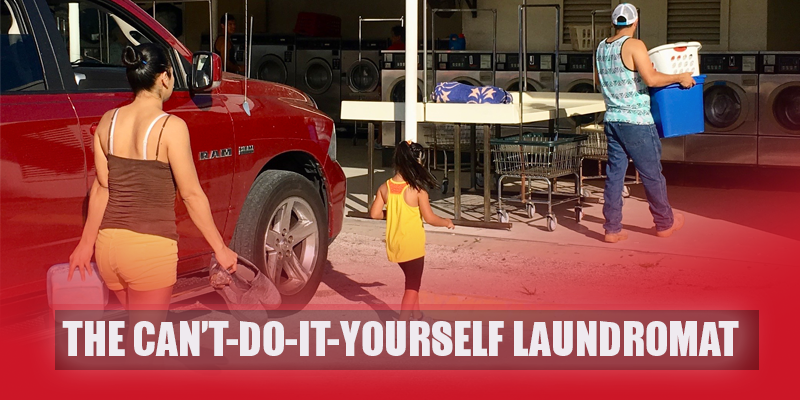The can’t-do-it-yourself laundromat

America’s classic laundromat was truly ahead of its time. An automated storefront business run without customer supervision.
Talk about idiot-proof. Washers didn’t even have a start button. Just toss in some clothes and coins and shut the door. Over at the dryer, loads tumbled on the turn of a knob.
Then the industry lost the plot. What was once very simple got complicated. Laundromats were re-engineered from do-it-yourself to can’t-do-it-yourself.
Take the changer: Bills in, coins out. Easy-peasy.
But that swift cash-to-cash transaction wasn’t good enough for some. They brought in a rival — the loyalty card kiosk — to stop coin circulation at the front door.
Proprietary card pay evolved over the years to where patrons now walk up to a kiosk and have to navigate language, method and amount before pulling out their wallet. Oh, and for most first-timers, there’s added screen time to register name, phone number and zip code.
All that prep work before moving on to a washer or dryer.
Got questions? Messed up? No problem. Flag down an attendant.
And there’s the rub: A dependence on skilled labor. The very thing self-service laundries were designed to avoid.
Presenting a sophisticated network of payment modules to an unsophisticated public begs for oversight. An estimated eight-in-ten proprietary card pay stores are either fully- or partially-attended, according to a recent online poll at Facebook’s Laundromat Owners Showcase.
The hidden cost of plastic pay
Laundromat owners hire staff for different reasons. Some want to keep the peace, while others want a piece of the drop-off laundry pie.
Classic laundromats used a workaround by cozying up with the dry cleaners next door to keep an eye on the joint. When the tandems started going their separate ways some had the bright idea to install a counter and take in wash bundles. Surely that would cover payroll.
The concept was warmly embraced by equipment distributors who were tasked with laying out stores festooned with bells and whistles, including profitable pay-by-plastic systems.
You won’t find any cost associated with handholding at kiosks and readers because it’s discretely tucked away inside the store’s wash-dry-fold.
Pushing that time on the clock behind the counter is fine for a thriving full-service laundry, but how about one that’s strictly self-service or where drop-off never took off?
Those who are into loyalty cards but not into handling people’s clothes face a potential dilemma: They could go unattended except when it comes to the store’s pay format. In short, they’re stuck babysitting.
I cringe walking into a laundromat with bare drop-off shelves and a bored attendant. During one memorable visit to Tampa, the staffer’s main duty was helping arrivals calculate how much money to load onto cards and then refund any excess upon departure.
Employees? No thank you
Self-service laundromat owners are a different breed than their full-serve counterparts. They got in the business to get away from employees. I know, my dad was one of them. He hung up his deli apron and together we built up an unattended five-store chain relying on automation, not people.
The average 30-washer, 30-dryer-pocket coin-op employs 60 mechanized “workers” that don’t take lunch breaks and never miss a shift. If one goes on the fritz others fill the void. Heck, even the public pitches in by lifting, loading and folding for free.
The marvels of technology permit self-service laundromat operations to run on autopilot.
Doors and lights can be hardwired or app-controlled. Surveillance cameras are ready to serve as eyes-in-the sky. Machinery equipped with monitoring software and remote start capability is there for the taking. Changers sporting smartphone alerts and hopper live streaming are online.
And last, but not least, coin/token payment systems with built-in redundancy have demonstrated their reliability for decades.
Savvy unattended laundromat owners don’t fear machine break-ins. They circulate tokens to remove cash as good as loyalty cards — and at a fraction of the price.
The laundromat for TikTokers
Still think the classic laundromat setup is an old school relic? Consider this: Members of the TikTok Generation are known for short attention spans and poor money handling skills. Today’s modern take on the original self-serve laundry is just for them.
Coin changers and token dispensers remain the fastest and easiest kiosks to operate. Feed a bill and they do all the math.
Washer and dryer drops function the same way. A high or low value coin or token insertion automatically syncs with the machine’s computer and counts down in milliseconds.
Isn’t that what laundromat pay should be? Something customers of every generation can do by themselves without needing a babysitter — even TikTokers.

Laurance Cohen is part of the Imonex team and welcomes inquiries on innovative payment solutions for your business.
laurance@imonex.com
(954) 999-7785

